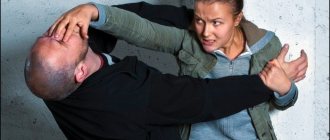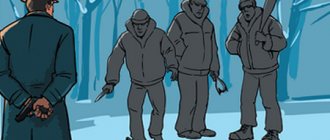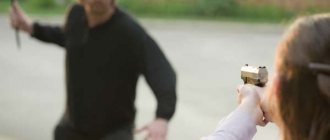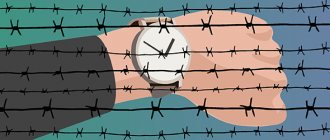Lawyer Spiridonov M.V. 10/29/2021 0 Comments
Necessary defense. Defense tactics
lawyer in Novosibirsk, lawyer in cases of necessary defense, lawyer under Art. 105 of the Criminal Code of the Russian Federation, lawyer under Art. 111 of the Criminal Code of the Russian Federation, criminal lawyer, imaginary defense, necessary defense, necessary defense, defense tactics, exceeding the necessary defense, limits of necessary defense, causing harm in a state of necessary defense, Art. 37 Criminal Code of the Russian Federation
Imaginary defense. Let's talk about this category.
An interesting issue related to the delimitation of the state of necessary defense and exceeding its limits is the issue of surprise of an attack, when the defender, due to the current situation, cannot objectively assess the degree and nature of the danger of an attack.
The Criminal Code of the Russian Federation provides that the actions of a defending person do not exceed the limits of necessary defense if this person, due to the surprise of the attack, could not objectively assess the degree and nature of the danger of the attack (Part 2.1. Article 37 of the Criminal Code of the Russian Federation).
An even more interesting legal category, in my opinion, is imaginary defense, that is, a situation when there is no real socially dangerous attack and the person mistakenly assumes its presence.
Imaginary defense. Case studies
So Tsaplin (surname changed) was found guilty and convicted of causing Shirokov (surname changed) and Koshkin (surname changed) grievous harm to health by exceeding the limits of necessary defense.
On September 26, 2010, at about 00:15, in front of the village club building, a quarrel occurred due to personal hostility between Tsaplin, who was intoxicated, and Shirokov, Koshkin and Metelkin (surname changed), who were also intoxicated. During the quarrel, Metelkin pushed Tsaplin, who, fearing further use of violence against him and the girl who was with him (Bragina (surname changed), committed actions that did not correspond to the nature and degree of public danger of the attack: snatching a folding souvenir knife from his pocket, Tsaplin deliberately stabbed Shirokov in the stomach with this knife, causing him bodily injury in the form of a penetrating stab wound to the abdominal cavity, resulting in serious harm to health.
.
Shirokov punched Tsaplin in the face. Then Koshkin threw Tsaplin to the ground, sat on top of him and began punching him in various parts of his body. Tsaplin, in response, committed actions that did not correspond to the nature and degree of public danger of the encroachment on the part of Koshkin: he deliberately inflicted at least eight blows to Koshkin with the above knife in various parts of the body, including the left chest and axillary areas, Tsaplin caused Koshkin bodily injuries in the form of a stab. - an incised wound to the left axillary region with damage to the lateral thoracic artery and vein, resulting in serious harm to health, dangerous to human life.
False defense
Judicial practice knows cases where a dirty intent to deal with the enemy was disguised as a noble defense. The essence of the insidious plan is this: the attacker wants to cause harm to the health (or death) of his enemy with impunity. By deliberate actions he provokes the future victim. And when the latter shows aggression, then, under the guise of defensive actions, the criminal inflicts physical damage. At the same time, the offender knows that he will defeat the victim, sometimes he supplies weapons of physical violence.
If you follow and prove the “wolf in sheep’s clothing” idea, then there will be no talk of any turnover or exceeding the limits. The offender will be punished as under normal circumstances. True, if the criminal himself suffers, then the person who succumbed to the provocation will bear responsibility for this.
Considering the case, the court of second instance concluded:
Since there were three attackers, the attack took place at night and was unexpected for Tsaplin, he could not objectively assess the degree of danger and the nature of the attack. Therefore, the court’s conclusion that the actions of the convicted person exceeded the limits of necessary defense permissible in this situation is illegal and unfounded.
Tsaplin acted in accordance with the nature of the unlawful encroachment and the degree of its danger, and in accordance with the rules of Part 2.1 of Art. 37 of the Criminal Code of the Russian Federation, Tsaplin’s actions in causing grievous harm to the health of Shirokov and Koshkin do not exceed the limits of necessary defense.
The court's verdict against Tsaplin was overturned, the criminal case was dismissed due to the lack of corpus delicti in his actions (Determination of the judicial panel for criminal cases of the Sverdlovsk Regional Court dated April 15, 2011 No. 22-3970/2011).
Concept
Necessary defense, from the point of view of the law, is the protection of the personality and rights of the person directly defending himself and/or other persons, from criminal attacks on them, with permitted harm to the attacker.
This concept is included in a complex of circumstances that exclude the recognition of a crime, and the legality of these circumstances is regulated by Chapter 8 of the Criminal Code of the Russian Federation
Let's move on to another example of imaginary defense
Shishkin (surname changed) was charged with committing crimes under Part 1 of Article 105 (murder), paragraph “b” of Part 3 of Article 111 of the Criminal Code of the Russian Federation (deliberate infliction of grievous bodily harm against two or more persons).
At the court hearing, it was established that between Shishkin and Ushkov (last name changed), Ulyanov (last name changed), who were intoxicated, a conflict occurred, during which Ulyanov began to push Shishikn out of the car, and Ushkov, in turn, began to pull him out of the car. Shishkin's clothes from the car, after which he threw him to the ground. Ushkov and Ulyanov began throwing punches and kicks at Shishkin’s body.
The latter, defending himself from blows, exceeding the limits of necessary defense, choosing a method and defense disproportionate to the attack, deliberately inflicted five blows to Ushkov with a knife in the area where vital organs were located - the chest, as well as one blow with a knife to the left thigh, causing him bodily injuries incompatible with life, from which Ushkov died at the scene, as well as multiple non-penetrating blind stab wounds to the chest, causing minor harm to health.
In addition, Shishkin, defending himself from blows, exceeding the limits of necessary defense, choosing a method and defense that was disproportionate to the attack, deliberately inflicted one blow to Ulyanov in the abdomen with a knife he had on him, causing him grave harm to his health due to the danger to life.
Immediately after this, Shishkin, taking into account the current situation caused by the encroachment on him by Ushkov and Ulyanov, mistakenly believing that Semenov and Krutikov (surnames changed) who had approached the place of conflict intended to attack him, exceeding the limits of necessary defense, deliberately, with a knife in his possession, struck two blows to the chest area of Semyonov, causing injuries that resulted in grievous harm to health on the grounds of danger to life, as well as one blow with a knife to the chest area of Krutikov, causing grievous harm to health on the grounds of danger to life.
Having examined the evidence presented by the parties, the court came to the conclusion that there was a real encroachment on the part of Ushkov and Ulyanov against Shishkin, the actions of the defendant were caused by the desire to defend themselves from the unlawful encroachment of the attackers, but their actions were not associated with violence dangerous to Shishikin’s life and did not pose an immediate threat of such violence.
Shishkin’s actions in relation to the victims Semenov and Krutikov were caused by the previous situation caused by the encroachment of Ushkov and Ulyanov, which gave the defendant reason to believe that a real attack was being made on him, while he also did not realize, due to the current situation, the error of his assumption.
At the same time, Shishkin also exceeded the limits of protection permissible in the conditions of the corresponding real attack, since in this case the actions of the victims were also not associated with violence dangerous to Shishkin’s life, and did not pose an immediate threat of such violence.
By a court verdict, Shishkin was found guilty of committing crimes under Part 1 of Article 108 (murder committed when the limits of necessary defense were exceeded) and Part 1 of Article 114 of the Criminal Code of the Russian Federation (causing grievous harm to health when the limits of necessary defense were exceeded).
Conditions and limits of legality of necessary defense
In accordance with the Resolution of the Plenum of the Supreme Court of the Russian Federation dated September 27, 2012 No. 19 “On the application by courts of legislation on necessary defense,” there are several conditions by which it is determined whether the right to necessary defense has arisen at all:
1. At the time of commission, the crime creates a real danger for the defender . This means there is an actual use of violence or a threat that is about to be implemented. Understanding this, a person defends himself in all possible and available ways. It is important that the threat is not in his imagination, but in reality.
Example No. 3 . Ignatova P.R. The criminals found him at home, broke into his apartment, tied him up and began to search his home in search of gold, while they had weapons in their hands and made death threats. The situation created a real impression that robbers could cause serious harm to health and even life. If in the process of self-defense of Ignatov one of the criminals gets hurt, he will not be held responsible.
Example No. 4 . Rodionov A.A. I was threatened for a long time by strangers. Rodionov did not know who they were or what they looked like and did not contact the police. When two men rang the bell at the front door and he saw them through the peephole, Rodionov opened the door and immediately hit one of those who came in the head with a tire iron. The man died; he turned out to be an employee of Vodokanal, who came with a partner at the request of Rodionov’s wife to fix a leak in the bathroom. In this case, the threat to life was only Rodionov’s imagination, nothing more. There is no reality of danger for him here, so there is no necessary defense.
Signs of actual danger to life may be suffocation, demonstration of weapons, explosive devices, arson, an attempt to push from a height, etc.
2. There must be a public danger from the criminal's actions.
In other words, defense is possible in response to a serious crime where there is a significant violation of human rights. In some cases, a crime is committed, the elements of which are formally provided for by the criminal code, but the nature of it is not dangerous enough to take defensive action.
For example, a minor act, such as stealing apples from an orchard, although it is a crime, does not create a sufficient public danger to use aggressive violence against the thief. In such situations, Art. 37 of the Criminal Code of the Russian Federation does not apply.
3. The necessary defense must be timely. It is appropriate if the encroachment has already begun or there is an imminent immediate threat that is about to begin. Late actions (when the encroachment has already ended) will not be considered defense. It will be similar to ordinary revenge - “an eye for an eye, a tooth for a tooth.”
Example No. 5 . For taxi driver E.N. Pavlov attacked by an attacker who, using a chokehold, tried to take possession of the victim’s car. Pavlov offered active resistance and delivered a strong blow to the face with his fist. A decision was made against him to refuse to initiate a criminal case under Art. 37 of the Criminal Code of the Russian Federation, since there was a real threat to life from the attacker, “here and now.”
Example No. 6 . Under the same circumstances, the attacker, by the time the crushing blow was inflicted on him with a fist, had already abandoned his criminal intentions. He saw that Pavlov was much superior to him in physical parameters and was about to leave, but Pavlov caught up with him and beat him. In this example, there was no reason for such “defense” on the part of the taxi driver, since the threat had already passed.
In many cases, it is extremely difficult for the victim to determine the time point at which the threat began to materialize. Basically, everything that happens, both attack and defense, lasts seconds. It is sometimes impossible to “put everything into pieces,” when one person actually perceived a threat to life, and the other really had intentions to cause harm.
It should be taken into account that a non-standard life situation is perceived by everyone emotionally, not always objectively. Therefore, in some cases, the law allows the recognition of necessary defense when the victim was not clear about the end of the assault.
Example No. 7 . Mironova P.R. beaten by two men while committing a robbery. They knocked him down and began kicking him, including to the head. One of the criminals said to the other, “Give me that brick over there, now we’ll finish it off.” During the period when he went a couple of meters away to get a brick, the victim was able to cope with the rest, and then struck the man who returned with the brick in the face and body. At the trial, the attacker claimed that, having seen how his partner was immobilized, he changed his mind about using the brick and wanted to throw it away, in connection with this Mironov P.R. there was no reason to defend myself. The court took the side of the victim; based on the situation, Mironov objectively assessed the circumstances as still dangerous to his life.
Sometimes the attack may not be immediate, but ongoing. Let's say torture (Article 117 of the Criminal Code of the Russian Federation) which involves systematic beating of the victim. In judicial practice, there were cases in which torture lasted for many days, and in some cases such horror could last for several years. It is considered that during this entire period the victim has grounds for protection. In the event of resistance and infliction of violence against the tormentor, the actions of the victim will be regarded as necessary defense.
4. You can only defend yourself against criminal acts . Thus, when a person is lawfully detained (for example, by police officers on suspicion of committing a crime), resistance can never be considered a necessary defense. On the contrary, for the use of violence against a government official in connection with the exercise of official powers, a criminal case may be initiated under Art. 318 of the Criminal Code of the Russian Federation.
The above are general conditions. They allow you to determine whether there was a need to defend yourself. A person who is defending himself against a non-life-threatening attack must not exceed the limits that are established by the judge in each case separately.
Conclusion
As we can see from the above example, when assessing the actions of the defender, the court took into account the extremely short period of time between the suppression (exceeding the limits of necessary defense) by Shishkin of the unlawful encroachment on the part of Ushkov and Ulyanov and the emergence of an imaginary threat from the approaching Semenov and Krutikov.
The court came to the conclusion that this circumstance, taking into account the intensity of the assault committed, did not allow the defender to adequately assess the situation in terms of establishing the presence and degree of threat posed by surrounding persons (sentence of the Baryshevsky City Court of the Sverdlovsk Region, a certificate based on the results of a study of the practice of application by courts of the rules on necessary defense and other circumstances excluding the criminality of the act, in cases considered in 2009 - the first half of 2011).
Thus, in practice, both the category of surprise of an attack is used when assessing the actions of the defender within the framework of necessary defense, and the category of imaginary defense.
Each attack is associated with a traumatic situation for the defender, which must also be taken into account; this issue will be discussed in the article: Correlation of necessary defense with a traumatic situation. How can the combination of these two categories help defense?
Author – lawyer Mikhail Vladimirovich Spiridonov










